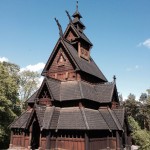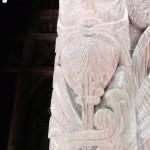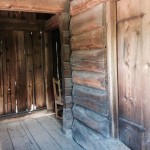I always enjoy folk museums, and the Norsk Folkemuseum was extensive with clusters of buildings depicting life in different eras and places.
A highlight was seeing the stave church from Gol. It was very similar to the Borgund stave church we saw a few days ago, but a little bigger and more ornate. In talking to the docent I learned that it was so deteriorated by 1884 when it was moved to Bigdøy, a peninsula owned by the King and adjacent to downtown Oslo, that they only moved the best preserved pieces, primarily the inner structure and staves. The current church is only 1/3 original. In reconstructing the church at Bigdøy, they copied the Borgund church to construct the outer walkway and roof. However the interior is almost entirely original. Inside, the twelve staves are painted with black swirling designs in lime wash and are topped with masks, which they believe represent the apostles. The log walls and ceiling of the semicircular apse where the priest would have been were covered in paintings from 1652. Like the Borgund church, benches for the elderly lined the walls in the nave where the congregation stood, but here the benches had a line routed near the edge, and the indentation was painted black. Similarly, a routed black line ran along the centers of the St. Andrew’s crosses which added strength between the staves. When they moved the church in the 1880s they removed the pulpit and windows which had been added after the reformation, because they wanted to return the church to its original condition. However they left the paintings.
Ornate carvings in the wood surrounding the three doors into the nave depicted interlocking lines reminiscent of Celtic patterns, and also an image of what looked like the Scot’s pagan Green Man. The docent said that the Norsk pre-Christian pantheon included a god like the Celtic Green Man.
Another highlight for me was to see Norwegian homes from the 1700s. They were log houses with a sheltering porch or outer door. We saw barns where the farm animals would have spent the winters, and kitchen gardens where the family would have grown vegetables. We saw store houses where food was saved for the winter. We saw a dairy building where cheese was made and small houses for loggers. We know in the 1700s our ancestors lived in rural Aust-Agder, and at least some were farmers or cotters. These log houses would have been familiar to them.



